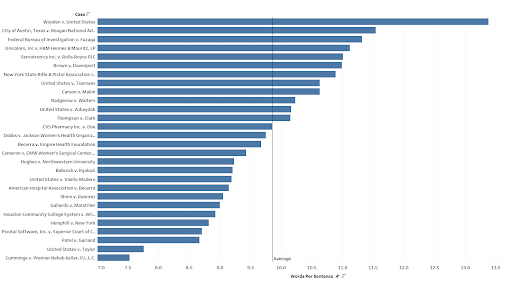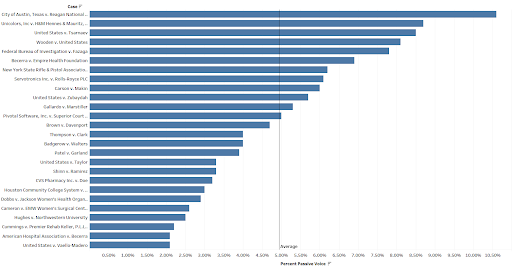How Well-Written Are Granted Cert Petitions?
So far the Court has granted 26 cases on cert for the upcoming term. Here, we look at these cert petitions based on different measures of writing quality.
 Ed. note: This article first appeared on The Juris Lab, a forum where “data analytics meets the law.”
Ed. note: This article first appeared on The Juris Lab, a forum where “data analytics meets the law.”
The Supreme Court receives thousands of petitions each year. The Justices choose from these fewer than 70 cases to hear on the merits. So far the Court has granted 26 cases on cert for the upcoming term. This post looks at these cert petitions based on different measures of writing quality.
Good legal writing is often defined by the phrase “Plain English” with short and to the point sentences. While a granted petition might seem like it should make good use of best practices for petition writing, there is still substantial variation among the petitions from which cert was granted for the upcoming term. Overall length of petition is one way to holistically look at petitions. While shorter petitions may be preferred, short petitions that sacrifice essential points are probably not as helpful as more robust petitions.
The length of the petitions granted on cert for the 2021 Term varied greatly. We begin with overall word counts.

While the average word count was over 7,500 words the range was from under 2,500 words to over 9,000 words. The longest petition was in American Hospital Association v. Becerra, dealing with the power of the Department of Health and Human Services to set reimbursement rates. It is a question of the decision making power deferred to the agency by Congress.
The next graph looks at the number of sentences in each petition to see if this differs from the words measure.

Here, three petitions had over 1,000 sentences with the average number of sentences near 800. Patel v. Garland had the most sentences of the batch. Patel deals with whether presenting false information to the government should make an individual ineligible to obtain a green card. The other two cases with over 1,000 words were American Hospital and Cummings v. Premier Rehab, a case about whether certain statutes that provide remedies for discrimination should provide compensation for emotional distress.
With words and sentence data we can begin to examine sentence complexity with a words per sentence ratio.

Here we see that the shortest petition, the one in Wooden v. United States, dealing with the definition of multiple offenses under the Armed Career Criminal Act, has the most words per sentence with almost 13.5. The average words per sentence was under 10 and the fewest came in Cummings v. Premier Rehab. Other cases with few words per sentence and thus less sentence complexity include United States v. Taylor (a case further defining the phrase “crime of violence”) and Patel v. Garland. These petitions with fewer words per sentence should be easier to read, which is generally seen as helpful to the justices.
To validate the complexity from words per sentence a secondary readability measure was employed. Flesch Grade Level provides the approximate grade level of the text based on word, sentence, and syllable counts.

The average Flesch grade level was just under 7.8. Cummings and Taylor had the two lowest grade level scores which accords with the findings from words per sentence. The cases with the highest grade level scores or the most complex writing according to this measure were FBI v. Fazaga and Carson v. Makin. Fazaga deals with procedures in cases dealing with government surveillance and Carson is a case about the use of government financial aid to attend schools that provide religious or “sectarian” instruction.
Another measure of complexity is the percentage of complex words (using a complex word dictionary) in each petition.

There was considerable variation in this percentage among the petitions. The average percent of complex words was just under 19%. The highest percentage of complex words was found in Becerra v. Empire Health dealing with the calculation of payments for hospitals serving predominately low income patients. The lowest percentage of complex words was found in Wooden v. United States followed by Brown v. Davenport. Brown deals with when a federal habeas corpus court can grant relief.
A final measure that looks at the writing quality of the petition is the percentage of sentences with passive language. Passive language is generally described as detracting from the overall writing quality in legal documents.

The average amount of passive language across the petitions was around 5%. The two petitions with the lowest percentages of passive language were American Hospital and U.S. v. Vaello-Madero. Vaello-Madero looks at whether the United States violated due process rights of Puerto Rican citizens by not including them in the Supplemental Security Income program. The petition with the most passive at just over 10.5% of sentences was City of Austin v. Reagan National Advertising. This case examines whether the distinction in Austin’s code between when digitized and non-digitized signs may be used violates the Constitution.
The 26 petitions granted for review in the upcoming term present many distinctions across their texts. Some are easier to read while others are more abstruse. Still, all of them were granted by the Court, which is a significant feat. This goes to show that the Court is not looking for a single template in writing but is willing to accept different variations along these measures in the cases the Justices grant.
Adam Feldman runs the litigation consulting company Optimized Legal Solutions LLC. For more information write Adam at afeldman@thejurislab.com. Find him on Twitter: @AdamSFeldman.







